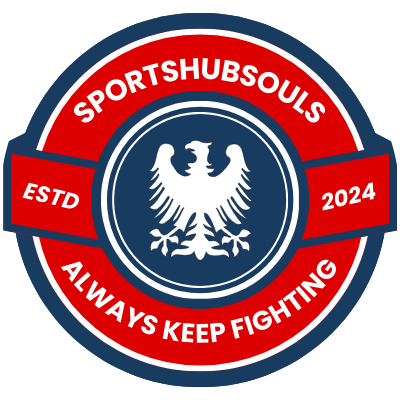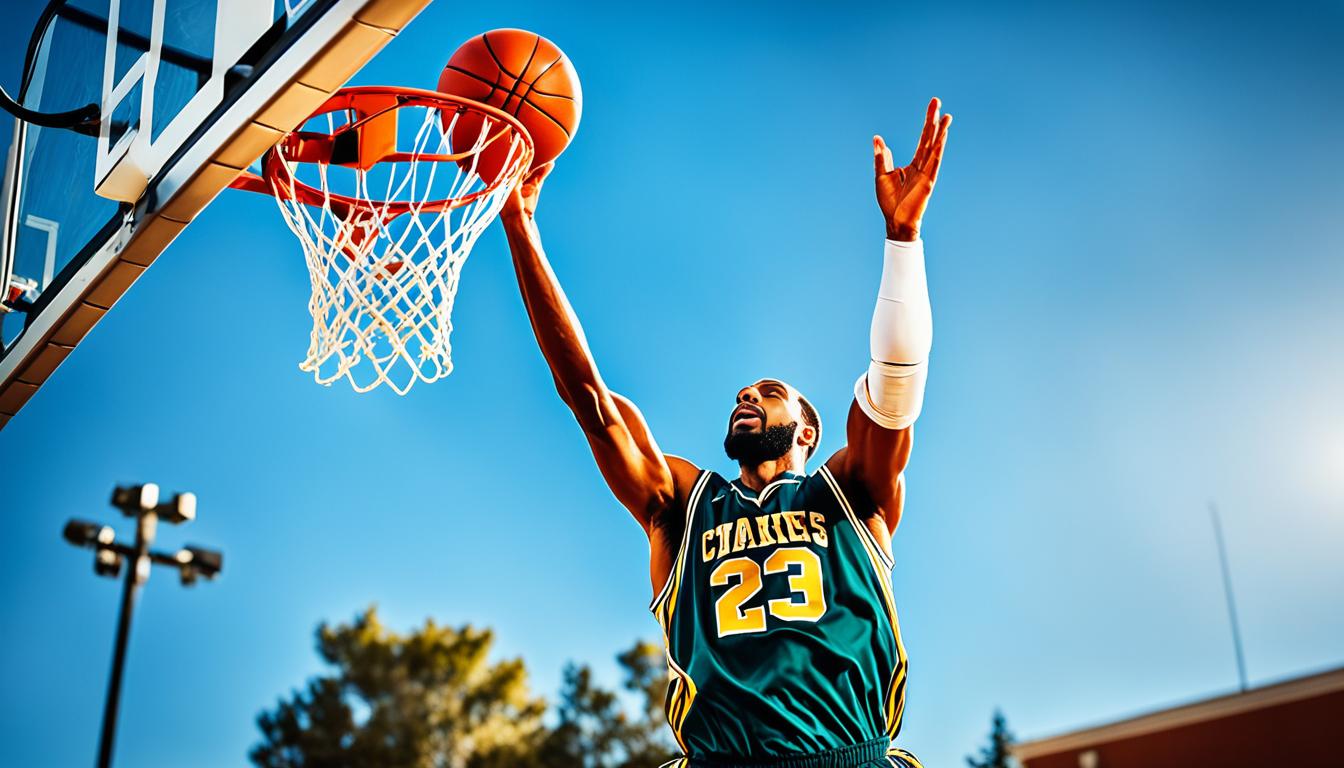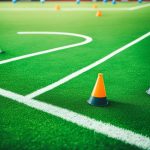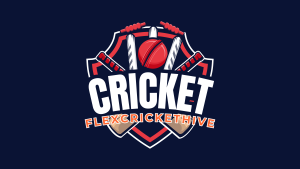Are you tired of being on the bench while others dominate the basketball court? Do you want to take your skills to the next level and become a formidable player? We have uncovered six proven strategies that will elevate your basketball game and help you outshine the competition. Are you ready to step up your game and leave your opponents in awe?
Key Takeaways:
- Master the basics of dribbling to improve ball control and hand-eye coordination.
- Focus on shooting accuracy by refining your form and follow-through.
- Enhance your quickness and agility through dedicated footwork drills.
- Improve your passing skills by practicing various types of passes and effective communication.
- Develop strong defensive skills through proper footwork and hand positioning.
Dribbling: Mastering the Basics
Dribbling is a fundamental skill in basketball that requires good ball control and hand-eye coordination. To become a proficient dribbler, it is crucial to practice specific drills that focus on these aspects.
One of the most important aspects of dribbling is maintaining control while handling the ball. This can be achieved by keeping your hand on top of the ball and using your fingertips to guide it. By practicing drills that emphasize ball control, you can improve your ability to maneuver the ball effectively during games.
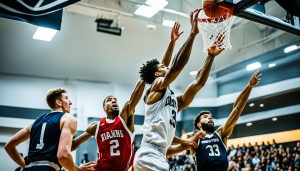
Incorporating both hands in your dribbling routine is also essential for becoming a well-rounded player. By practicing drills that force you to use your non-dominant hand, you can develop ambidextrous skills and increase your on-court versatility.
Another way to enhance your dribbling skills is by challenging yourself with various dribbling drills. These drills can include simple exercises such as dribbling around cones or advanced drills that involve crossover moves and behind-the-back dribbles. By continually pushing yourself and exploring different techniques, you can enhance your creativity and confidence in dribbling the ball.
Improving your dribbling skills not only enhances your ability to create scoring opportunities but also boosts your overall ball-handling capabilities. It is a skill that requires dedication and practice, but by consistently incorporating dribbling drills into your training routine, you can develop better ball control, hand-eye coordination, and basketball skills.
Dribbling Drills for Improved Ball Handling
Here are a few dribbling drills that can help you improve your ball handling:
- Figure Eight Dribble: Set up two cones or markers in the shape of a figure-eight. Dribble the ball around the cones, moving your body in a fluid motion.
- Stationary Dribbling: Stand in one place and practice dribbling the ball with both hands, focusing on maintaining control and using your fingertips.
- Crossover Dribble: Dribble the ball in front of you, then quickly switch hands and dribble the ball behind your back. Repeat this motion, alternating hands.
- Speed Dribble: Start in a stationary position and dribble the ball as fast as you can up and down the court. Focus on maintaining control while dribbling at high speed.
These drills can be customized and combined to suit your skill level and specific areas you want to improve. Practice these drills regularly to enhance your basketball dribbling skills.
| Dribbling Drill | Description |
|---|---|
| Figure Eight Dribble | Set up two cones or markers in the shape of a figure-eight. Dribble the ball around the cones, moving your body in a fluid motion. |
| Stationary Dribbling | Stand in one place and practice dribbling the ball with both hands, focusing on maintaining control and using your fingertips. |
| Crossover Dribble | Dribble the ball in front of you, then quickly switch hands and dribble the ball behind your back. Repeat this motion, alternating hands. |
| Speed Dribble | Start in a stationary position and dribble the ball as fast as you can up and down the court. Focus on maintaining control while dribbling at high speed. |
Shooting: Accuracy and Form
Shooting is a crucial skill in basketball that can greatly impact your performance on the court. To improve your shooting accuracy, it’s essential to focus on your form and follow-through. By practicing proper shooting technique, you can increase your shooting percentage and become a more reliable scorer for your team.
When shooting, pay attention to the following elements of your form:
- Balance: Maintain a solid base with your feet shoulder-width apart. This will provide stability and help you generate power from your legs.
- Grip: Hold the ball with your shooting hand using your fingertips, keeping your wrist relaxed and your elbow underneath the ball.
- Alignment: Align your shooting hand, forearm, and elbow with the target (the rim). This positioning will increase your shooting accuracy.
- Release: Focus on a smooth and consistent release, extending your shooting arm fully and snapping your wrist at the end for proper rotation.
Remember to follow through with your shooting motion, extending your arm towards the hoop and holding the follow-through until the ball reaches the basket. This ensures a better shooting trajectory and increases the likelihood of a successful shot.
Quote: “Perfect practice makes perfect.” – Kobe Bryant
Consistent practice is key to improving your shooting skills. Incorporate shooting drills into your training routine to refine your technique and build muscle memory. These drills can simulate game-like situations and enhance your shooting accuracy under pressure.
Shooting Drills
| Drill Name | Description |
|---|---|
| Spot Shooting | Set up shooting spots around the perimeter of the court and practice shooting from each spot, focusing on your form and accuracy. |
| Free Throw Contest | Compete with a teammate or challenge yourself to make a certain number of free throws in a row. This drill improves your concentration and shooting consistency. |
| Game-Scenario Shooting | Simulate game situations by incorporating movement and different shooting angles into your shooting drills. This helps improve your shooting accuracy in dynamic situations. |
By incorporating these shooting drills into your training regimen and focusing on proper shooting technique, you can enhance your shooting accuracy and become a more reliable scorer on the basketball court.
Footwork: Quickness and Agility
Good footwork is essential in basketball as it allows us to achieve open shots, effectively defend opponents, and become well-rounded players. Incorporating footwork drills into our practice routine is crucial for improving our quickness and agility on the court. By focusing on shuffling, jumping, and various footwork techniques, we can enhance our overall performance.
Why Footwork Matters
Footwork is the foundation of basketball skills. It enables us to move quickly and efficiently, helping us create separation from defenders and maintain balance while making plays. Whether it’s pivoting, sprinting, or changing direction, proper footwork enhances our speed, agility, and coordination.
“Good footwork is the difference between achieving a great shot and being blocked by a defender.”
Footwork Drills for Quickness and Agility
To develop quickness and agility, we can incorporate the following footwork drills into our training routine:
- Agility ladder drills: Using an agility ladder, we can perform various exercises such as ladder hops, lateral movements, and quick steps. These drills improve our foot speed, coordination, and enhance our ability to change direction rapidly.
- Dot drill: Set up a series of dots or markers on the ground in different patterns and jump between them quickly. This drill helps improve our explosiveness, coordination, and footwork.
- Defensive slides: Practice defensive slides by moving laterally in a low stance, keeping the feet wide, and maintaining good balance. This drill enhances our lateral quickness and improves our ability to stay in front of opponents defensively.
The Importance of Consistent Practice
Consistency is key when it comes to improving our footwork. By incorporating footwork drills into our practice routine regularly, we can strengthen our lower body muscles, improve our coordination, and develop muscle memory. This will ultimately translate into better performance on the court.
Passing: Effective Communication
Good passing is a key component of successful basketball gameplay. To improve your passing skills, practice different types of passes, such as chest passes, bounce passes, and overhead passes. Aim for accuracy and precision, targeting your teammate’s chest or stomach. Effective communication and teamwork are crucial for successful passing in basketball.
Passing is not just about getting the ball to another player; it’s about effective communication and understanding your teammates’ movement and positioning on the court. By utilizing different passing techniques, you can facilitate better ball movement, create scoring opportunities, and keep the defense off balance.
One of the most common passes in basketball is the chest pass, where you push the ball from your chest using both hands and snap your wrists for added accuracy. The chest pass is a powerful and direct pass that enables quick ball movement.
Another fundamental pass is the bounce pass, which involves bouncing the ball off the floor while aiming for your teammate’s waist or chest. The bounce pass is useful in situations where there is a defender close to your teammate, making it harder to intercept.
The overhead pass, also known as the baseball pass, involves using both hands to throw the ball over your head and towards your teammate. This pass is often used for long-distance and cross-court passes, as it allows for greater accuracy and power.
Effective passing requires good court vision, anticipation, and timing. It’s important to read the game, assess the movement of your teammates and opponents, and choose the appropriate pass to maintain possession and create scoring opportunities.
Here is a table summarizing the different basketball passing techniques:
| Passing Technique | Description |
|---|---|
| Chest Pass | A powerful pass using both hands, pushing the ball from the chest. |
| Bounce Pass | A pass that involves bouncing the ball off the floor towards the receiver. |
| Overhead Pass | A pass thrown over the head, suitable for long-distance and cross-court passes. |
Practice these passing techniques in drills and scrimmage games to enhance your passing skills. Emphasize accuracy, timing, and communication with your teammates. By improving your passing abilities, you can elevate your performance on the court and contribute to effective teamwork.
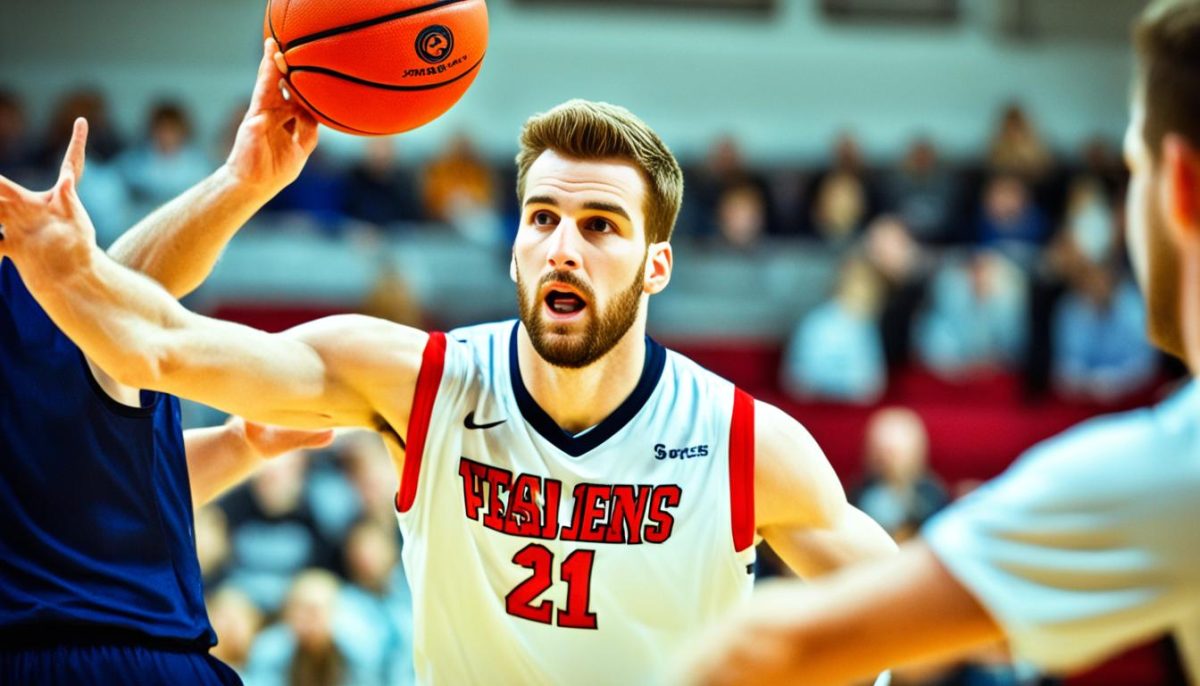
Defense: Footwork and Hand Positioning
Strong defensive skills are vital in basketball. To improve your defense, focus on your footwork and hand positioning.
When playing defense, it’s crucial to stay low and maintain an athletic stance. This allows you to react quickly and move efficiently on the court. Keep your knees bent and your weight on the balls of your feet. By staying low, you’ll have better balance and be ready to make defensive moves.
In addition to proper footwork, hand positioning is essential in defense. Keep your hands active and ready to contest shots or disrupt passing lanes. Make it difficult for your opponent to make plays by maintaining a high hand position and active hand movements.
Practice defensive drills that focus on improving your footwork and reaction time. Incorporate lateral shuffles, defensive slides, and pivots into your training routine. These drills will enhance your agility and help you stay in front of your opponent.
“Good defense starts with good footwork and hand positioning. By focusing on these fundamentals and practicing defensive drills, you can become a formidable defender on the court.”
Defensive Footwork Drill
One effective defensive footwork drill is the “4 Corners” drill. This drill helps improve your agility and foot speed while simulating defensive movements.
| Drill Steps | Description |
|---|---|
| 1. Set up four cones in a square formation. | Place the cones at the corners of a 10-foot square. |
| 2. Start at one cone. | Assume a defensive stance and begin the drill. |
| 3. Shuffle to the next cone. | Move laterally by shuffling your feet to the next cone. |
| 4. Sprint diagonally to the next cone. | Change direction and sprint diagonally to the third cone. |
| 5. Backpedal to the final cone. | Rotate and backpedal to the starting cone to complete the drill. |
Perform this drill multiple times, focusing on maintaining proper defensive stance, reacting quickly to changes in direction, and staying low throughout the drill. This footwork drill will help improve your agility and defensive capabilities on the court.
By mastering defensive footwork and hand positioning, you can significantly impact the game and become a valuable asset to your team.
Rebounding: Positioning and Timing
Rebounding is a critical skill in basketball that can have a significant impact on game outcomes. To improve your rebounding abilities, it is essential to focus on proper positioning, timing, and developing your jumping ability. We’ll explore effective rebounding techniques that will help you secure more rebounds and contribute to your team’s success on the court.
Positioning
Positioning plays a crucial role in rebounding. When preparing for a rebound, position yourself between your opponent and the basket, ensuring you have a clear path to the ball. By establishing good positioning, you can gain a competitive advantage and increase your chances of grabbing rebounds effectively. Remember to maintain a wide stance with your feet shoulder-width apart, keeping your body low and ready to explode upwards.
“Positioning is the key to grabbing rebounds. By getting in front of your opponent and securing the optimal position, you put yourself in the best position to succeed.”
Timing
Timing is another crucial aspect of successful rebounding. By mastering the art of timing, you can anticipate the trajectory of the ball and make your move at the right moment. Watch the flight of the ball and use your instincts to judge when to jump. It’s important to remember that jumping too early or too late can negatively impact your chances of securing the rebound. With practice, you can refine your timing and become a formidable force on the boards.
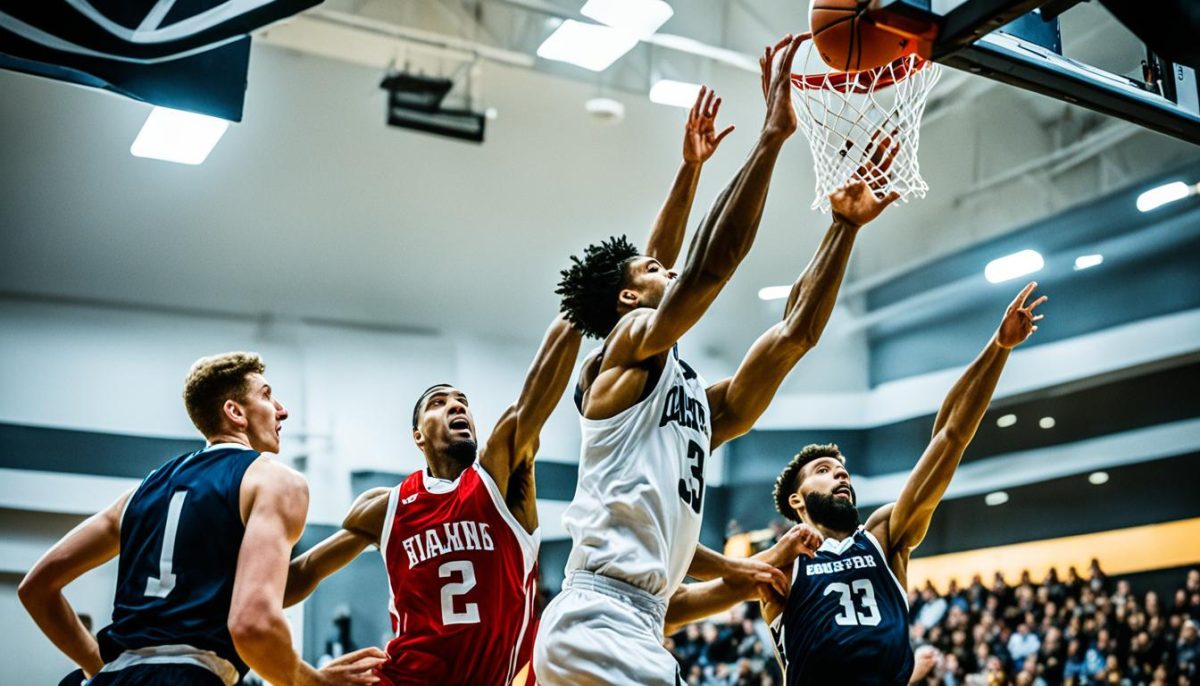
Boxing Out
One effective technique in rebounding is boxing out. When boxing out, you use your body to create space between your opponent and the basket, preventing them from getting in a better position to grab the rebound. To box out effectively, get your body between your opponent and the ball, extend your arms, and push your opponent away from the basket. This technique gives you an advantage by limiting your opponent’s access to the rebound and allowing you to secure the ball with greater ease.
Key Takeaways
- Position yourself well to gain an advantage in rebounding situations.
- Master the art of timing to anticipate the ball’s flight and make your move at the right moment.
- Use boxing out techniques to create space between your opponent and the basket, increasing your chances of securing the rebound.
Improving your rebounding skills requires a combination of positioning, timing, and technique. By incorporating these techniques into your training and practice sessions, you can become a dominant force on the boards, contributing to your team’s success in games.
Endurance: Building Stamina
Basketball is a fast-paced sport that demands a high level of endurance. To excel on the court, it is crucial to improve your basketball endurance through cardiovascular exercise, full-court games, and conditioning drills.
Cardiovascular exercises like running or cycling are effective ways to boost your stamina. These activities increase your heart rate, improve lung capacity, and enhance overall cardiovascular fitness. By including regular cardio workouts in your training routine, you can develop the endurance needed to keep up with the intense pace of basketball.
Playing full-court games is an excellent way to simulate real-game scenarios and improve your basketball endurance. Engaging in full-court games helps you get accustomed to the physical demands of the sport, such as sprinting up and down the court, defending opponents, and executing offensive plays. The more you play full-court games, the better your endurance will become.
Conditioning drills specifically designed for basketball can also contribute to building stamina. These drills focus on improving your agility, speed, and overall fitness levels. Incorporate drills like suicides, shuttle runs, and ladder drills into your training sessions to challenge your cardiovascular system and enhance your endurance on the court.
Tips for Building Basketball Endurance:
- Engage in regular cardiovascular exercise such as running or cycling.
- Include full-court games in your practice sessions to simulate game-like conditions.
- Incorporate conditioning drills that target agility, speed, and overall fitness.
- Gradually increase the intensity and duration of your workouts to build endurance over time.
- Stay hydrated and properly fuel your body to optimize performance and recovery.
- Listen to your body and prioritize rest and recovery to prevent overtraining and injuries.
By focusing on building your basketball endurance, you can prolong your energy levels, maintain a high level of performance throughout games, and ultimately elevate your overall game.
Mental Focus: Staying in the Zone
Mental focus is a crucial element of basketball performance. When you’re able to maintain a sharp mental focus, you can make better decisions, react quickly, and perform at your best. Here are some strategies to help you stay in the zone:
- Eliminate distractions: Identify potential distractions in your environment and take steps to minimize or eliminate them. This could include turning off your phone, finding a quiet space to practice, or mentally blocking out external noises and distractions during games.
- Stay focused on the task at hand: Concentrate on the present moment and the specific actions you need to take. Avoid dwelling on past mistakes or worrying about future outcomes. By staying focused on the immediate task, you can perform with clarity and precision.
- Maintain a positive attitude: Your mindset plays a significant role in your ability to stay in the zone. Cultivate a positive attitude by focusing on what you can control, embracing challenges as opportunities for growth, and maintaining confidence in your abilities.
- Develop a routine: Establish a pre-game or pre-practice routine that helps you prepare mentally and physically. This routine can help you get into the right mindset and create a sense of familiarity and focus before stepping onto the court.
“In order to excel on the basketball court, we must train not just our physical skills but also our mental focus. By eliminating distractions, staying present, maintaining positivity, and following a routine, we can elevate our performance and unlock our full potential.” – Basketball Pro
Remember, mental focus is a skill that can be developed and strengthened through consistent practice and deliberate effort. By incorporating these strategies into your training and game-day routines, you can enhance your performance and achieve greater success on the basketball court.
Ball Handling: Control and Confidence
When it comes to basketball, ball handling is a fundamental skill that can greatly impact your overall performance on the court. The ability to control the ball and make moves with confidence is essential for executing dribbling techniques, driving to the basket, and creating scoring opportunities for yourself and your teammates.
To improve your ball handling skills, it’s important to practice a variety of dribbling drills that focus on honing your control and coordination with both hands. These drills challenge you to maintain control of the ball in various situations, such as stationary dribbling, change of pace, and navigating through defenders.
Here are a few effective dribbling drills to incorporate into your daily training routine:
- Stationary Dribbling: Stand in one spot and practice dribbling the ball with your dominant hand, then switch to your non-dominant hand. This drill helps improve hand-eye coordination and ball control.
- Figure 8 Drill: Set up a series of cones or markers in the shape of a figure 8. Dribble the ball around the cones using both hands, focusing on maintaining control and executing smooth transitions.
- Two-Ball Dribbling: Using two basketballs, practice dribbling with both hands simultaneously. This drill enhances ambidexterity, coordination, and overall ball handling ability.
- Speed Dribble: Dribble the ball as quickly as possible from one end of the court to the other, maintaining control and keeping the ball low to the ground. This drill helps improve dribbling speed and reaction time.
By consistently incorporating these drills into your training routine, you’ll develop better ball handling skills, allowing you to confidently take on defenders, make precise passes, and create scoring opportunities for yourself and your teammates.
Remember, ball handling is not only about executing fancy dribbling moves but also about having the control and confidence to make the right decision in any given situation on the court.
| Dribbling Drill | Focus Area |
|---|---|
| Stationary Dribbling | Hand-eye coordination, ball control |
| Figure 8 Drill | Control, coordination, transitions |
| Two-Ball Dribbling | Ambidexterity, coordination |
| Speed Dribble | Dribbling speed, reaction time |
Teamwork: Collaborating for Success
In basketball, teamwork is the backbone of a successful team. It involves effective communication, trust, and a shared goal. By working together, players can enhance their overall performance and achieve greater success on the court.
Effective communication is vital for basketball teamwork. Players must learn to communicate with each other both verbally and non-verbally. Clear and concise communication ensures that everyone is on the same page, leading to better coordination and decision-making during the game.
Trust is another crucial aspect of teamwork. Players must trust their teammates’ abilities, decision-making, and effort. Trust allows players to rely on each other, creating a strong foundation for collaboration and unity.
Having a common goal is essential for effective teamwork. Players must understand and work towards a shared objective, such as winning the game or achieving a specific outcome. A common goal fosters team cohesion and motivates players to work together towards a common purpose.
“Teamwork is the ability to work together toward a common goal. It is the fuel that allows common people to attain uncommon results.” – Andrew Carnegie
Benefits of Basketball Teamwork
Strong basketball teamwork leads to numerous benefits for both individual players and the team as a whole. Here are some key advantages:
- Improved coordination and synergy on the court
- Enhanced decision-making and problem-solving abilities
- Increased scoring opportunities through effective passing and collaboration
- Better defensive strategies through coordinated positioning and communication
- Greater resilience and support during challenging moments in the game
- Overall team chemistry and unity, fostering a positive and motivating environment
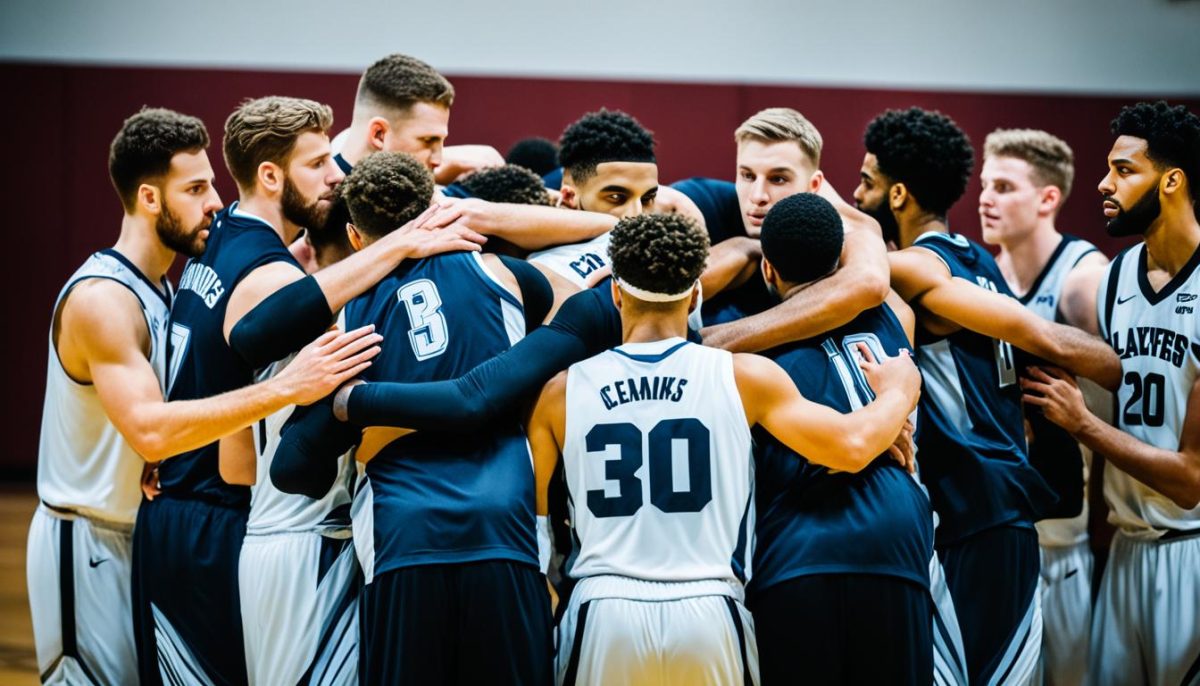
Elements of Effective Teamwork
| Element | Description |
|---|---|
| Communication | Clear and effective exchange of information between teammates |
| Trust | Belief and confidence in each other’s abilities and commitment |
| Collaboration | Working together towards a shared goal, combining individual efforts |
| Support | Providing encouragement and assistance to teammates during the game |
| Respect | Valuing and appreciating each other’s contributions and perspectives |
By focusing on these elements of effective teamwork, basketball players can develop a strong sense of camaraderie and achieve remarkable results on the court.
Conclusion
Improving your basketball skills requires dedication, practice, and a focus on various aspects of the game. By implementing these six proven strategies, you can enhance your overall performance and take your basketball skills to the next level. Remember that consistent effort and a positive mindset are key to becoming a better player.
First, mastering the basics of dribbling will improve ball control and hand-eye coordination, enabling you to maneuver on the court with confidence. Second, focusing on shooting accuracy and form will help you make precise shots from different distances and angles. Third, developing quickness and agility through footwork drills will enhance your ability to outmaneuver opponents and excel in different game situations.
In addition, honing passing skills and effective communication will contribute to seamless teamwork and create scoring opportunities. Defensive techniques involving footwork and hand positioning will enable you to become a formidable opponent, while rebounding techniques will give you an advantage in securing possession. Building endurance through cardio exercises and maintaining mental focus will help you stay competitive throughout the game, and finally, improving ball handling will allow you to control the game confidently.
By incorporating these strategies into your training routine, you will witness significant progress in your basketball skills, as well as an overall improvement in your basketball game. So, lace up your sneakers, hit the court, and let these strategies guide you towards becoming a better basketball player.
FAQ
How can I improve my dribbling skills?
To improve your dribbling, practice drills that focus on ball control and hand-eye coordination. Work on maintaining control while dribbling, incorporating both hands, and challenging yourself with various dribbling drills.
What can I do to improve my shooting accuracy?
To improve your shooting accuracy, focus on your form and follow-through. Aim to release the ball consistently and practice shooting from different distances and angles. Incorporate shooting drills into your training routine to enhance your shooting skills.
How can I enhance my footwork in basketball?
Good footwork is essential in basketball. Incorporate footwork drills into your practice routine to improve your quickness and agility on the court. Focus on shuffling, jumping, and other footwork techniques to enhance your overall performance.
What are some tips for better passing in basketball?
To improve your passing skills, practice different types of passes, such as chest passes, bounce passes, and overhead passes. Aim for accuracy and precision, targeting your teammate’s chest or stomach. Effective communication and teamwork are crucial for successful passing in basketball.
How can I become a better defender in basketball?
To improve your defense, focus on your footwork and hand positioning. Stay low, keep your hands active, and move your feet to stay in front of your opponent. Practice defensive drills that enhance your agility and reaction time to become a formidable defender on the court.
What can I do to improve my rebounding skills?
To improve your rebounding skills, work on positioning yourself well, mastering timing, and developing jumping ability. Get in front of your opponent and use techniques like boxing out to secure rebounds effectively.
How do I build endurance for basketball?
Basketball is a fast-paced sport that requires endurance. Focus on cardiovascular exercises like running or cycling to improve your stamina. Incorporate full-court games and conditioning drills into your training routine to build endurance and stay competitive throughout the game.
How can I improve my mental focus in basketball?
To improve your mental focus, eliminate distractions, stay focused on the task at hand, and maintain a positive attitude. Develop a routine that helps you prepare mentally and stay in the zone during games and practices.
What are some tips for better ball handling in basketball?
Ball handling is a crucial skill that allows you to control the ball and make moves with confidence. Improve your ball handling by practicing dribbling drills that challenge you to maintain control with both hands. Incorporate ball handling exercises into your daily routine to enhance your overall skill set.
How can I improve my teamwork in basketball?
Basketball is a team sport, and teamwork is essential for success. Improve your teamwork skills by communicating effectively with your teammates, trusting each other, and working together to achieve a common goal. Emphasize the importance of collaboration and unity on and off the court.
What are some strategies to improve my overall basketball skills?
Improving your basketball skills requires dedication, practice, and a focus on various aspects of the game. By implementing these proven strategies, such as dribbling, shooting, footwork, passing, defense, rebounding, endurance, mental focus, ball handling, and teamwork, you can enhance your overall performance and take your basketball skills to the next level.
